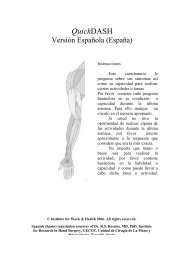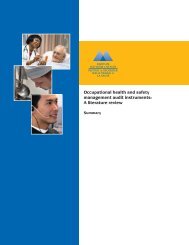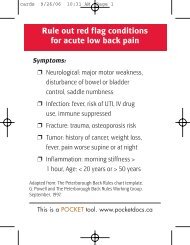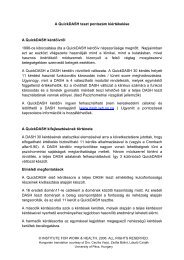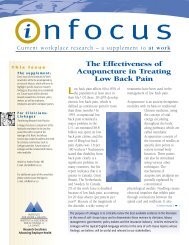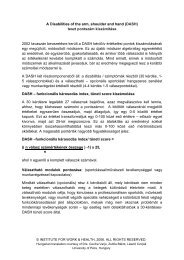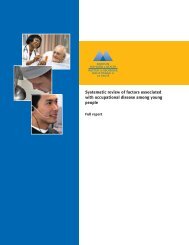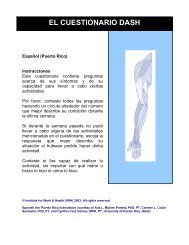A systematic review of injury/illness prevention and loss control ...
A systematic review of injury/illness prevention and loss control ...
A systematic review of injury/illness prevention and loss control ...
- No tags were found...
You also want an ePaper? Increase the reach of your titles
YUMPU automatically turns print PDFs into web optimized ePapers that Google loves.
A key part <strong>of</strong> the literature would be classified as grey literature (i.e. literaturethat has not been peer-<strong>review</strong>ed). The grey literature is difficult to identify ina <strong>systematic</strong> manner. Studies done specifically for a workplace, association orgovernmental body are <strong>of</strong>ten not published in documents found in thedatabases we searched, nor are conference proceedings. The grey arealiterature was also tracked with the help <strong>of</strong> content experts.In addition, a specific author search was conducted on three authors knownby practitioners as experts in the IPC area to ensure the relevance <strong>of</strong> thesearch.2.3 Level 1 - Selection for relevanceDevelop abstract <strong>and</strong> screening tool for Level 1 <strong>and</strong> Level 1 B <strong>review</strong>Because a large number <strong>of</strong> articles were identified by the search, therelevancy exclusions had to be completed in two steps. Level 1 <strong>review</strong>involved <strong>review</strong>ing only the title <strong>and</strong> abstracts. Level 1 B <strong>review</strong> involved<strong>review</strong>ing the full article. One person <strong>review</strong>ed the articles at Level 1 <strong>and</strong>Level 1 B. However, two <strong>review</strong>ers had to agree that a study did not have a<strong>control</strong> group or concurrent comparison (see Table 1, question 7).Team members were provided with a “Reviewer Guide” for each level <strong>of</strong><strong>review</strong> as the project progressed. Reviewer Guides were developed to reduceindividual biases during the <strong>review</strong>. The guides listed each question to beanswered <strong>and</strong> the definitions team members were to use while <strong>review</strong>ing thearticles. The guides were developed during the <strong>review</strong> process, as team input<strong>and</strong> group consensus were a vital part <strong>of</strong> the project. At each stage <strong>of</strong> the<strong>review</strong> process, the <strong>review</strong> team collectively <strong>review</strong>ed a small set <strong>of</strong> articlesusing a draft guide <strong>and</strong> met to discuss the <strong>review</strong> experience. Clarifications<strong>and</strong> additions were made to the guides based on team consensus.In Level 1, the preliminary exclusion step, article titles <strong>and</strong> abstractsidentified during the literature search were evaluated to determine the study’srelevance to the <strong>review</strong> questions based on the criteria listed in Table 1 (seealso Appendix F for the Level 1 guide to <strong>review</strong>ers). The grey blocksindicate answers that led to the automatic exclusion <strong>of</strong> studies. The studiesthat were not excluded advanced to the next stage <strong>of</strong> the <strong>review</strong>. If the answerwas "unclear," the study also moved to the next stage.Level 1 B was a <strong>review</strong> <strong>of</strong> the full article using the questions from the Level 1<strong>review</strong>, as well as an outcome question <strong>and</strong> a <strong>control</strong> group question (seeTable 1, questions #6 <strong>and</strong> #7).A <strong>systematic</strong> <strong>review</strong> <strong>of</strong> <strong>injury</strong>/<strong>illness</strong> <strong>prevention</strong> <strong>and</strong> <strong>loss</strong> <strong>control</strong>programs (IPCs)13



